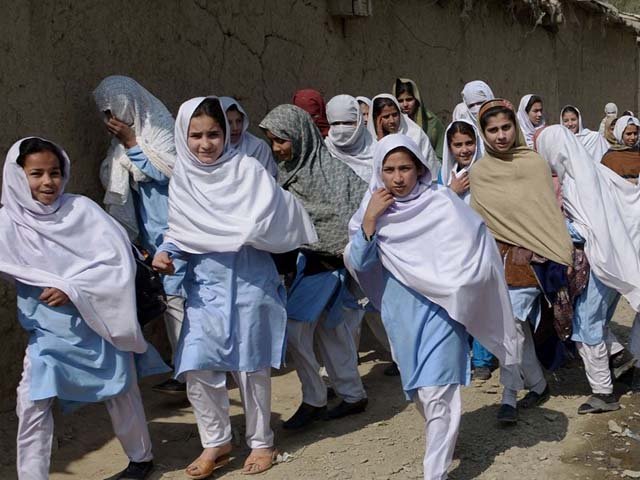
Forcing schoolgirls to wear an abaya is not the solution to harassment
The clothes that women wear in Pakistan have never been a matter of sartorial preferences or aesthetics alone. The length of the kameez, to the donning of the hijab itself has always been at the heart of a debate that encompasses matters as diverse as gender politics and women’s rights to female visibility and reclamation of public spaces. Even in Pakistani dramas, the morally upright woman is always shown to be dressed ‘modestly’ while the one who is ‘morally loose’ will be shown wearing jeans or a top.
Therefore, on the face of it, the Haripur district’s education office’s decision to enforce a dress code for schoolgirls, which instructs them to wear an abaya/chadar, may not seem particularly surprising. But this move cannot be viewed in isolation. More than the enforcement itself, it is the motive behind the decision that warrants much scrutiny. The rationale used to justify the implementation of this dress code is that if the schoolgirls wear this piece of clothing, it will curb the growing number of complaints by schoolgirls of harassment and eve teasing. Samina Altaf, District Education Officer (DEO) in Haripur, stated in a circular that,
“Instruct all students to use gown/abaya or chadar to veil/conceal/cover up theirself in order to protect them from any unethical incident.”
DEO Haripur orders all govt schools for girls in Haripur district to direct its students to war an abaya or a chadar or veil to "protect them from any unethical incident" - says the matter "may be treated as most important" pic.twitter.com/45Mus20whx
— omar r quraishi (@omar_quraishi) September 13, 2019
Govt in Haripur, KP can't fix education so they decided to go after little girls & made it mandatory for them to wear abaya/chadar. Can we stop this constant, sick obsession with women & their clothing? & focus on education instead of hating on India for making it to the moon?
— Banannie (@journo_ON) September 14, 2019
The decision and the reasoning behind it reflect a greater malaise plaguing our society. It perpetuates a culture of victim-blaming by holding women and their choice of attire as the reasons behind harassment. It appears that the solution to reducing harassment is not to reprimand the men who carry out these heinous activities but to instead tell girls to cover themselves up even more because it is their attire which prompts such behaviour in the first place. The fact that this kind of regressive thinking has now essentially been endorsed by the DEO in Haripur sets a worrisome precedent.
This kind of flawed moral policing is by no means new. Female students at the National University of Sciences and Technology (NUST) were fined for wearing jeans and had been instructed to dress in a ‘decent’ manner. Similarly, the business school at the University of Engineering and Technology (UET) made it compulsory for women to wear head scarves. But what makes the Haripur matter alarming is the fact that it was put into effect in response to increasing cases of harassment. Altaf stated that,
“…I have taken the decision in light of my responsibility to secure girls from inner and outer dangers.”
But the truth of the matter is that harassment will take place regardless of what clothes women are made to wear. By shifting the focus from the harassers to the victims, we teach our girls to repress their voices and to blame themselves whenever they are catcalled or harassed. Schools impart institutionalised learning, and perpetuating a dress code only for female students ingrains a false sense of humiliation for young girls. Contrary to taking the focus away from their bodies, the narrative becomes about their body, as an object of desire, lust and most importantly, shame.
Women’s participation in public spaces already faces many hindrances because of the very real fear of harassment. Therefore, when the attempt to tackle harassment starts with women and not the perpetrators, it only reinforces the notion that how women behave in public places must be dictated and further limited. The enforcement of a dress code gives control of women’s bodies back to men, both in institutions and at home. Naturally, it is not surprising that some have come out in support of this decision, and one only hopes such polices do not become the new standard.
Appreciation for Haripur authorities for issuing dress code order for local schools. Now a selected section of desk liberals is expected to pressurise the authorities to undo the order, which is in line with Islam and the constitution of Pakistan. https://t.co/hEMf0e8pdu
— Ansar Abbasi (@AnsarAAbbasi) September 14, 2019
It is the responsibility of the state to protect its citizens from any untoward incidents. If there have been complaints of harassment, either on school campus or outside, it must be addressed by ensuring that the perpetrators are held responsible. A failure to act on the part of the government is a lapse in the working and implementation of the law. Rather than using schools and other narrative building outlets to launch a campaign centred around girls’ clothes, it is important to build a perspective that de-stigmatises women’s clothing, holds the harassers accountable, and ensures the safe and active participation of women in public spaces. Forcing schoolgirls to wear an abaya is not the solution.




COMMENTS
Comments are moderated and generally will be posted if they are on-topic and not abusive.
For more information, please see our Comments FAQ